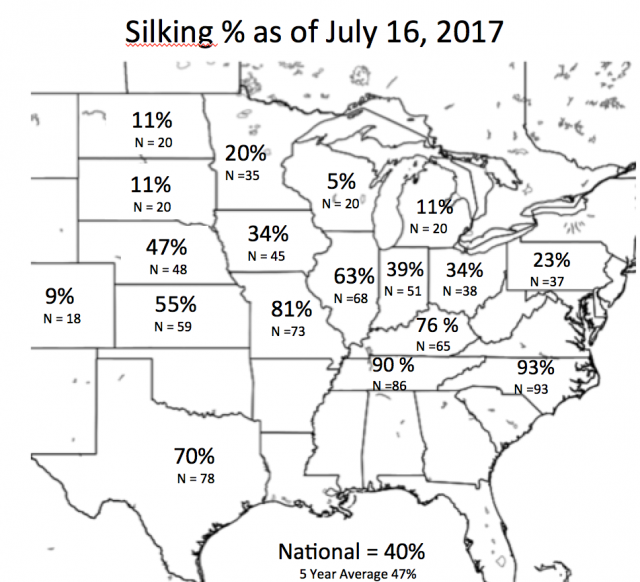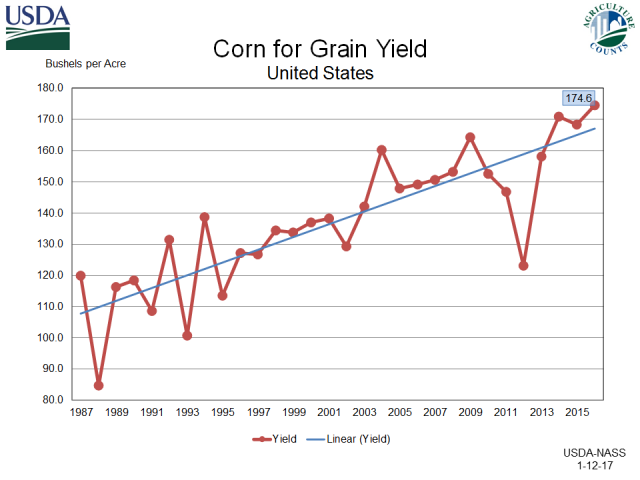Heat During Corn Pollination 8 years ago
July 18, 2017
- Corn Pollination is ongoing in the Corn Belt.
- In most cases silk desiccation from heat only occurs in combination with dryness.
- For the most part, the driest areas will escape the most prolonged heat this week.
- The most prolonged hot temperatures will occur in places that have adequate soil moisture.
- Our expectations continue for near trendline yields (but shy of a record).
Current Dry Areas
According to Purdue University:
Beginning about 2 weeks before silk emergence, corn enters the period of grain yield determination most sensitive to drought stress. Nearly continual wilting of the plant due to drought stress at this stage can decrease yield 3 to 4 percent per day. During the silking and pollen shed period, severe stress may reduce yield up to 8 percent per day. During the 2 weeks following silking, severe stress may reduce yield up to 6 percent per day.
This year overall, drought stress has been limited to the western Corn Belt. Rainfall anomalies over the last 30 days:
.png)
Despite a dry 30-day period, timely showers and irrigation in Nebraska, Iowa and central Illinois should have provided adequate moisture for good yields in most fields. In addition long term soil moisture is near normal in most areas thanks to rainfall in the spring and recent showers.
.gif)
The notable exceptions are in southern Iowa and in the Dakotas. The Dakotas which have seen very dry weather and much of the corn crop is rated poor to very poor there.
Forecast for Heat
Purdue University also notes the conditions for heat stress, included in long form because of the valuable insight (emphasis added).
High-temperature damage to pollination in Indiana almost always occurs in conjunction with drought stress, rarely by itself. Thus, separating heat stress from drought stress effects on pollination is usually difficult.
Temperatures in excess of 95 degrees, especially when accompanied by low relative humidity, can dessicate exposed silks, but has little direct effect on silk elongation. The outer membrane of a pollen grain is very thin. As a result, high temperatures and low humidity can similarly desiccate pollen grains once they are released from the anthers of the tassel.
Growers often worry about the direct effects of high temperatures on the viability of the pollen grains. Indeed, pollen is likely damaged by mid-90's or greater temperatures, especially when accompanied by low relative humidity. Temperatures over 100 degrees may literally kill pollen.
The saving grace of the matter, however, is that pollen shed typically occurs during early to mid-morning hours before temperatures climb to such dangerous heights. Furthermore, pollen maturation occurs over time and 'fresh' pollen is available every morning until maturation is complete. Successful pollination can occur even during lengthy periods of high temperatures if soil moisture reserves are adequate to meet the plants' demands.
The forecast highs for the next few days, as forecasted by the National Weather Service.
Tuesday:
.png)
The heat builds and pushes to the east on Wednesday:
.png)
Thursday probably will see the hottest and most widespread readings:
.png)
The heat shrinks on Friday:
.png)
By Saturday, the forecast cools for most of Iowa:
.png)
By Sunday, northern areas are expected to see milder weather:
.png)
Taking into account the research from Purdue and the forecast over the next few days, stressful temperatures are most likely in the Plains, especially in Kansas. The heat will only desiccate the silks if there is a lack of moisture, and most areas have seen adequate moisture or are irrigated. The hottest areas are expected to be to the south of where the driest weather has been. Even still in those areas, it's likely that most pollen grains won't be subject to temperatures over 95°F, which will occur in the mid-afternoon. The exception may be in parts of central to western Kansas.
Furthermore, many southern fields have been pollinated. As of Sunday, 81% if Missouri's crop was silking, while Kentucky and Tennessee were also above the 5-year pace. The northern areas of most concern (like southern Iowa) are early in the pollination phases due to a slower development schedule than the 5-year average. Nearly two-thirds of the corn acreage in Iowa hasn't begin silking as of Sunday. In Iowa specifically, the highest concentration of corn acreage is to the north, which will mainly be in the upper 80s most of the week.

Yields
The historical corn yield graph shows the record to near record yields of the last few years and the low production year of 2012.

Throughout the growing season, WeatherBELL has stated that we expected yields to be near the trendline but not a record, more like the last few years than those from 2011-12. This outlook still holds as of mid-July despite the increase in noise that always happens this time of year.
Summary
Overall conditions for U.S. corn are not ideal, but they certainly are better than some of the poor yield years in recent memory (like 2011 and especially 2012). The areas that are likely to come out of this week in the poorest shape are the already drought-stricken areas of the northern Plains and in non-irrigated fields in southern Iowa, Nebraska and Kansas that are entering the most critical pollination phases. Still, a disastrous week is not anticipated for the nation's crop as a whole, though some fields may see lower yields due to a combination of factors.